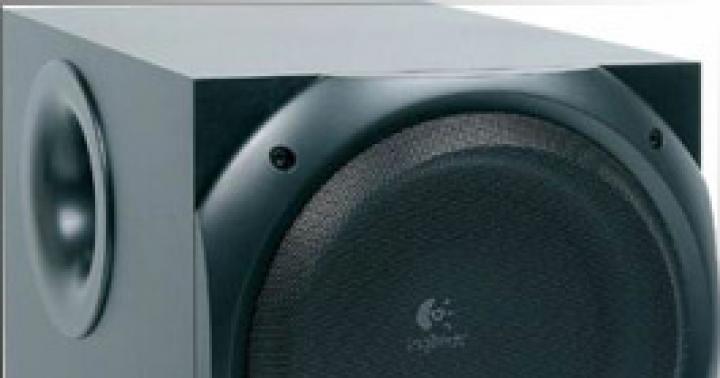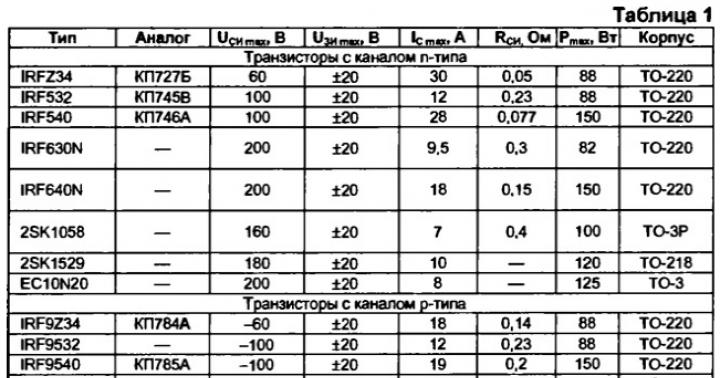
Let's check the validity of the formulas shown here using a simple experiment.
Let's take two resistors MLT-2 on 3 And 47 Ohm and connect them in series. Then we measure the total resistance of the resulting circuit with a digital multimeter. As we can see, it is equal to the sum of the resistances of the resistors included in this chain.

Measuring total resistance in series connection
Now let's connect our resistors in parallel and measure their total resistance.

Resistance measurement in parallel connection
As you can see, the resulting resistance (2.9 Ohms) is less than the smallest (3 Ohms) included in the chain. This leads to another well-known rule that can be applied in practice:
When resistors are connected in parallel, the total resistance of the circuit will be less than the smallest resistance included in this circuit.
What else needs to be considered when connecting resistors?
Firstly, Necessarily their rated power is taken into account. For example, we need to select a replacement resistor for 100 Ohm and power 1 W. Let's take two resistors of 50 ohms each and connect them in series. How much power dissipation should these two resistors be rated for?
Since the same direct current flows through series-connected resistors (for example 0.1 A), and the resistance of each of them is equal 50 ohm, then the dissipation power of each of them must be at least 0.5 W. As a result, on each of them there will be 0.5 W power. In total this will be the same 1 W.
This example is quite crude. Therefore, if in doubt, you should take resistors with a power reserve.
Read more about resistor power dissipation.
Secondly, when connecting, you should use resistors of the same type, for example, the MLT series. Of course, there is nothing wrong with taking different ones. This is just a recommendation.
Variable resistors differ from constant ones by the presence of a third terminal - a slider, which is a spring-loaded slider that can mechanically move along the resistive layer. Accordingly, in one extreme position of the slider the resistance between its terminal and one of the terminals of the resistive layer is zero, in the other - the maximum corresponding to the nominal resistance.
Since there are three pins, the variable resistor can be connected in two ways - as a simple resistor (then the output of the engine is combined with one of the outer pins), and according to a potentiometer circuit, when all three pins are activated. Both connection methods are shown in Fig. 5.2. Resistors, by their purpose, serve to convert voltage into current and back - in accordance with this, the circuit for the usual connection of a variable resistor serves to convert voltage U into current /, and the circuit of a potentiometer (voltage divider) - current / into voltage U. It seems that in the circuit Normally, it is not necessary to connect the engine output to one of the outer terminals - if you leave the unused extreme output “hanging in the air,” then nothing will change in principle. But this is not entirely true - interference from the electric field “walking” in space appears on the “hanging” terminal, and it is correct to connect the variable resistor exactly as shown in Fig. 5.2.
Rice. 5.2. Two ways to connect variable resistors
Variable resistors are divided into actual variables (to which the external adjustment knob is connected) and tuning ones - changed only during the process of setting up the circuit by rotating the slider with a screwdriver (see Fig. 5.1, below). Variable resistors have changed little throughout their existence, since the days of Michael Faraday's rheostat, and they all have the same disadvantages: mainly a violation of the mechanical contact between the slider and the resistive layer. This is especially true for cheap open tuning resistors such as SPZ-1 (in Fig. 5.1 below, far right) - imagine the operation of this resistor, for example, in a TV set in the atmosphere of a home kitchen!
Therefore, if possible, the use of variable resistors should be avoided or placed in series with constant ones so that they constitute only the necessary part of the total resistance value. Trim resistors are good at the stage of debugging the circuit, and then it is better to replace them with constant ones and provide on the board the ability to connect parallel and/or series constant resistors for final adjustment. It would seem that there is no escape from external variable resistors (like the volume control of a receiver), but this is not true either: the use of analog regulators with digital control provides an excellent alternative to variables. But this is difficult, and in simple circuits, if possible, you should install a multi-position step switch instead of a variable resistor - this is much more reliable.
A large number of people turn to radio stores to do something with their own hands. The main task of those who like to collect radios and circuits is to create useful items that will benefit not only themselves, but also those around them. A variable resistor helps to carry out repairs or create a device that operates from an electrical network.
Basic properties of variable resistors
When a person has a clear idea of the conventional elements of graphic display on diagrams, then he has the problem of transferring the drawing into reality. You need to find or purchase individual components of a ready-made circuit. Today there are a large number of stores that sell the necessary parts. You can also find elements in old broken radio equipment.
A variable resistor must be present in any circuit. It is found in any electronic devices. This design is a cylinder that includes diametrically opposed terminals. The resistor creates a limit on the flow of current in the circuit. If necessary, it will perform resistance, which can be measured in ohms. A variable resistor is indicated on the diagram in the form of a rectangle along with two dashes. They are located on opposite sides inside the rectangle. Thus, a person denotes power on his diagram.
The equipment, which is found in almost every home, includes resistors with a certain value. They are located along the E24 row and conventionally indicate the range from one to ten.
Types of resistors
Today there are a large number of resistors that are found in modern household electrical appliances. The following types can be distinguished:
- Heat-resistant varnished metal resistor. It can be found in lamp devices that have a power of at least 0.5 watts. In Soviet equipment you can find resistors such as those produced in the early 80s. They have different powers, which directly depend on the size and dimensions of the radio equipment. When there is no power symbol on the diagrams, then it is allowed to use a variable resistor of 0.125 watts.
- Waterproof resistors. In most cases, they are found in lamp-based electrical appliances that were manufactured in 1960. These elements are sure to be found in black-and-white TV and radios. Their markings are very similar to the designation of metal resistors. Depending on the rated power, they can have different sizes and dimensions.
Today, generally accepted markings of resistors are widely used, which are divided into different colors. This way you can quickly and easily determine the value without soldering the circuit. Thanks to color coding, you can significantly speed up the search for the required resistor. Nowadays, a large number of foreign and domestic companies are engaged in the production of such elements for microcircuits.

Main characteristics and parameters of a variable resistor
Several main parameters can be distinguished:

Specific characteristics are used during the design of the presented devices. These parameters apply to devices that operate at high frequencies:
A wirewound variable resistor is considered the main and main element in any electronic equipment. It is applied as a discrete component or component to an integrated circuit. It is classified according to basic parameters, such as method of protection, installation, nature of resistance changes or production technology.
Classification by general use:
- General purpose.
- Special purpose. They are high-resistance, high-voltage, high-frequency or precision.
Depending on the nature of the change in resistance, the following resistors can be distinguished:
- Permanent.
- Variables, adjustable.
- Adjusted variables.
If we take into account the method of protecting resistors, we can distinguish the following designs:

Connecting a variable resistor
A large number of people do not know how to connect a variable resistor. These elements often have two connection schemes. This work can be done by a person who has at least a little knowledge of electronics and has dealt with soldering microcircuits.

Manufacturing technology of variable resistors
There is a classification that depends on the resistor manufacturing technology. During the production process, different steps and patterns are used. Today we can distinguish the following designs:

Features of 10 kOhm variable resistors
Today in radio markets you can find a large number of elements for drawing up a diagram. The most popular is a 10 kOhm variable resistor. It can be variable, wire or adjustable. Its main distinguishing feature is single-turn operation. This type of resistor is designed to work in an electrical circuit where there is direct or alternating current.
The power rating is 50 volts and the resistance is 15 kOhm. These elements were produced in the mid-eighties, so today they can be found not only in specialized stores, but also in old radio circuits. The 10 kOhm variable resistor has several functional and possible analogues.

Variable resistor noise
Even new and reliable resistors at high temperatures, which are well above absolute zero, can become the main source of noise. A dual variable resistor is used in an electrical circuit in a microcircuit. The appearance of noise became known from the fundamental fluctuation-dissipation theorem. It is commonly known as the Nyquist theorem.
If the circuit contains a variable resistor SP with high resistance values, then a person will observe an effective noise voltage. It will be directly proportional to the roots of the temperature regime.
Resistors are one of the important elements of an electronic device circuit. Their main purpose is to limit or regulate the current in an electrical circuit. Fixed, variable and trimming resistors are produced. There are other classifications of their division.
Purpose
Resistors are a passive element of an electrical circuit that does not convert energy from one type to another. They have active resistance. Their main characteristic is nominal resistance. No less important is a characteristic such as power.
Variable resistors can change their resistance using an accessible adjuster. Act as a current or voltage regulator.
Trimmer resistors have a control that changes the resistance, but it is not available for manual adjustment. To do this you need to use a special screwdriver. These resistors are used only for setting the operating modes of a technical device and are not intended for frequent use.
Graphic designation
According to the standard, there are several options for the conventional graphic designation (CGO) of various variable resistors.
The figure shows UGOs used in Europe and Russia. The first two are a general designation, the third is a resistance with a linear characteristic depending on the angle of rotation of the control knob, the fourth is a resistance with a nonlinear dependence. The first and second types of resistors are used to switch on according to a potentiometer circuit, and the third and fourth types - according to a regulator circuit.
The tuning resistor, the designation of which is given below, is depicted in two ways according to the standard.

The first sign denotes resistors that act as current regulators. The second method is intended for resistors connected according to a potentiometer circuit.
In the USA, Japan and some other countries, other UGOs are used.
There are no fundamental differences, but it is good to know both designations.
Device
There are a large number of various designs of variable and trimming resistors with a power from tens of watts to several milliwatts. Some of them are shown in the photo below.

Trimmer resistors have almost the same structure as variables. They consist of movable and fixed parts placed in a common housing. The fixed part is a plate made of an insulating substrate, onto which a conductive layer is applied in an open circle. The ends of this layer are connected to two contacts.

The moving part acts as a current-collecting spring contact mounted on the axis. This ensures reliable connection with the conductive layer.
A slightly different device has a multi-turn trimmer resistor. It has a conductive layer applied to a straight rod, and the current-collecting contact moves parallel to it on a screw rod.

These two methods of changing resistance are used in all types of trimming resistors.
Types and varieties
According to the installation method, there are 2 types of trimmers - for surface mounting and surface mounting (SM). The first ones are large-sized; wall-mounted installation does not impose any special restrictions on the size of the elements. The latter are small-sized, and high demands are placed on their size. It should be borne in mind that the industry does not produce wirewound trimming resistors.
Single-turn resistors differ in the location of the control, which is usually accessible only with a special screwdriver. It can be located on the side or on top. It all depends on the position in which it is more convenient to access it. The body shape is usually cubic, less often cylindrical.

Multi-turn trimmers are mainly of two types - with a cubic and oblong body shape. The control can be located on the top or side, depending on the design requirements of the device.

There are other varieties of these resistors, but for this you need to refer to reference publications.
Connection schemes
The trimmer resistor circuit exists in two main versions. The first option is a rheostatic switching circuit, used as a current regulator. With this connection method, the initial or final terminal of the resistor and the middle one are used. Sometimes the middle pin is connected to one of the outer pins. This circuit is more reliable, since if the middle pin loses contact, the electrical circuit does not break.
The second connection option is a potentiometric circuit, where a resistor is used as a voltage divider. With this connection, all pins are used.
Of great importance is how the resistance of the trimmer changes depending on the angle of rotation of the control knob. This dependence is called a functional characteristic; there are three types.

The main characteristic is linear. As you can see, the resistance is proportional to the change in the angle of rotation of the handle. The other two are logarithmic and antilogarithmic, used mainly in amplifiers.

Resistor markings
In technical documentation, trimming resistors are always indicated in full. There is no unified marking system for trimmer resistors. Abroad, they have developed their own rules that do not coincide with ours. In Russia, the standard for variable resistors is GOST 10318-80.
The marking of trimming resistors contains the letters RP at the beginning of the designation - variable resistor. This is followed by the number 1 (non-wire), or 2 (wire). After that, the product development number is indicated through a hyphen. For example, RP1-4 should be read as follows: variable resistor, non-wire, model number 4.
After this, the permissible power in watts is indicated through a hyphen. For trimmers there is a standard range: 0.01; 0.025 and so on. A number of operating voltages are also defined. The standard provides a number of permissible deviations from the nominal resistance. Using all its positions, write down the resistor coding.
Application area
Trimmer variable resistors are widely used in electronic and electrical devices. They are used to adjust the current value in circuits and as voltage dividers. At low frequencies up to 1 megahertz, no problems are observed with their use.
When operating at high frequencies, the resistors’ own inductance and capacitance begin to affect; this factor must be taken into account. When selecting parts, you should pay attention to the operating frequency range. It is not recommended to work with the maximum permissible resistor parameters.
How to connect a resistor?
A resistor is an element of an electrical circuit, the main property of which is a certain active resistance. There are many types of resistors - constant, variable, varistors, thermistors, etc., as well as a lot of possible connection circuits.
In this article, we will look at the basic connection circuits and figure out how to connect a resistor.
Serial connection
Series connection is one of the main resistor connection schemes. Let's say we need to solder two resistors in a series connection. In this case:

If you need to connect more resistors, proceed in the same way (see figure). Remember, with a series connection, the total resistance of the circuit will be equal to the sum of the resistances of the resistors included in it.
Parallel connection
Parallel connection is also one of the main resistor connection schemes. To connect two resistors in parallel: 
- the first contacts of both resistors are soldered together and connected to the positive of the power source;
- the second contacts of both resistors are soldered together and connected to the negative side of the power source.
If you need to connect more resistors, proceed in the same way (see figure). The total resistance in a parallel connection is found by the formula: R1*R2*...*Rn/R1+R2+...+Rn.
Variable resistor
A variable resistor can be connected to the circuit either in series or in parallel. Its main feature is the fact that on its body itself there is a special regulator that can usually be rotated using a small screwdriver. By controlling the regulator, you can increase or decrease the resistance.


